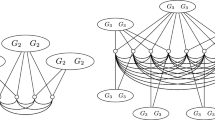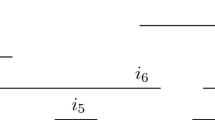Abstract
Interval relations play a significant role in constraint-based temporal reasoning, resource allocation and scheduling problems. For example, the intervals may represent events in time which may conflict or may be compatible, or they may represent tasks to be performed according to a timetable which must be assigned distinct resources like processors or people. In previous work [G93, GS93, G98], we explored the interaction between the interval algebras studied in artificial intelligence and the interval graphs and orders studied in combinatorial mathematics, extending results in both disciplines.
In this paper, we investigate algorithmic problems on tolerance graphs, a family which generalizes interval graphs, and which therefore have broader application. Tolerance graph models can represent qualitative and quantitative relations in situations where the intervals can tolerate a certain degree of overlap without being in conflict. We present a coloring algorithm for a tolerance graph on n vertices whose running time is O(n 2), given the tolerance representation, thus improving previously known results. The coloring problem on intervals has direct application to resource allocation and scheduling temporal processes.
Access this chapter
Tax calculation will be finalised at checkout
Purchases are for personal use only
Preview
Unable to display preview. Download preview PDF.
Similar content being viewed by others
References
K. Bogart, P. Fishburn, G. Isaak and P. Langley, Proper and unit tolerance graphs, Discrete Applied Math. 60 (1995) 37–51.
S. Felsner, Tolerance graphs and orders, J. of Graph Theory 28 (1998) 129–140.
S. Felsner, R. Müller, L. Wernisch, Trapezoid graphs and generalizations, geometry and algorithms, Discrete Applied Math. 74 (1997) 13–32.
M.C. Golumbic, Algorithmic Graph Theory and Perfect Graphs, Academic Press, New York, 1980.
M.C. Golumbic, Reasoning about time, Invited talk, AISMC-1 Karlsruhe, Germany, August 3–6, 1992, abstract in LNCS 737 (1993) p. 276.
M.C. Golumbic, Reasoning about time, in “Mathematical Aspects of Artificial Intelligence”, F. Hoffman, ed., American Math. Society, Proc. Symposia in Applied Math., vol. 55, 1998, pp. 19–53.
M.C. Golumbic and C.L. Monma, A generalization of interval graphs with tolerances, in: Proceedings 13th Southeastern Conference on Combinatorics, Graph Theory and Computing, Congressus Numerantium 35 (1982) 321–331.
M.C. Golumbic, C.L. Monma and W.T. Trotter Jr., Tolerance graphs, Discrete Applied Math. 9 (1984) 157–170.
M.C. Golumbic and R. Shamir, Complexity and algorithms for reasoning about time: a graph-theoretic approach, J. Assoc. Comput. Mach. 40 (1993), 1108–1133.
M.C. Golumbic and Ann N. Trenk, Tolerance Graphs, monograph in preparation.
R. Hayward, Weakly triangulated graphs, J. Combin. Theo. Ser. B 39 (1985) 200–209.
R. Hayward, C. Hoàng, and F. Maffray, Optimizing weakly triangulated graphs, Graphs and Combinatorics 6 (1990) 33–35. Erratum to ibid, 5:339–349.
L. Lovász, Normal hypergraphs and the perfect graph conjecture, Discrete Math. 2 (1972), 253–267.
G. Narasimhan and R. Manber, Stability number and chromatic number of tolerance graphs. Discrete Applied Math. 36 (1992) 47–56.
A. Raghunathan, Algorithms for weakly triangulated graphs, Univ. of Calif. Berkeley, Technical Report CSD-89-503 (April 1989).
Author information
Authors and Affiliations
Editor information
Editors and Affiliations
Rights and permissions
Copyright information
© 2002 Springer-Verlag Berlin Heidelberg
About this paper
Cite this paper
Golumbic, M.C., Siani, A. (2002). Coloring Algorithms for Tolerance Graphs: Reasoning and Scheduling with Interval Constraints. In: Calmet, J., Benhamou, B., Caprotti, O., Henocque, L., Sorge, V. (eds) Artificial Intelligence, Automated Reasoning, and Symbolic Computation. AISC Calculemus 2002 2002. Lecture Notes in Computer Science(), vol 2385. Springer, Berlin, Heidelberg. https://doi.org/10.1007/3-540-45470-5_19
Download citation
DOI: https://doi.org/10.1007/3-540-45470-5_19
Published:
Publisher Name: Springer, Berlin, Heidelberg
Print ISBN: 978-3-540-43865-6
Online ISBN: 978-3-540-45470-0
eBook Packages: Springer Book Archive




